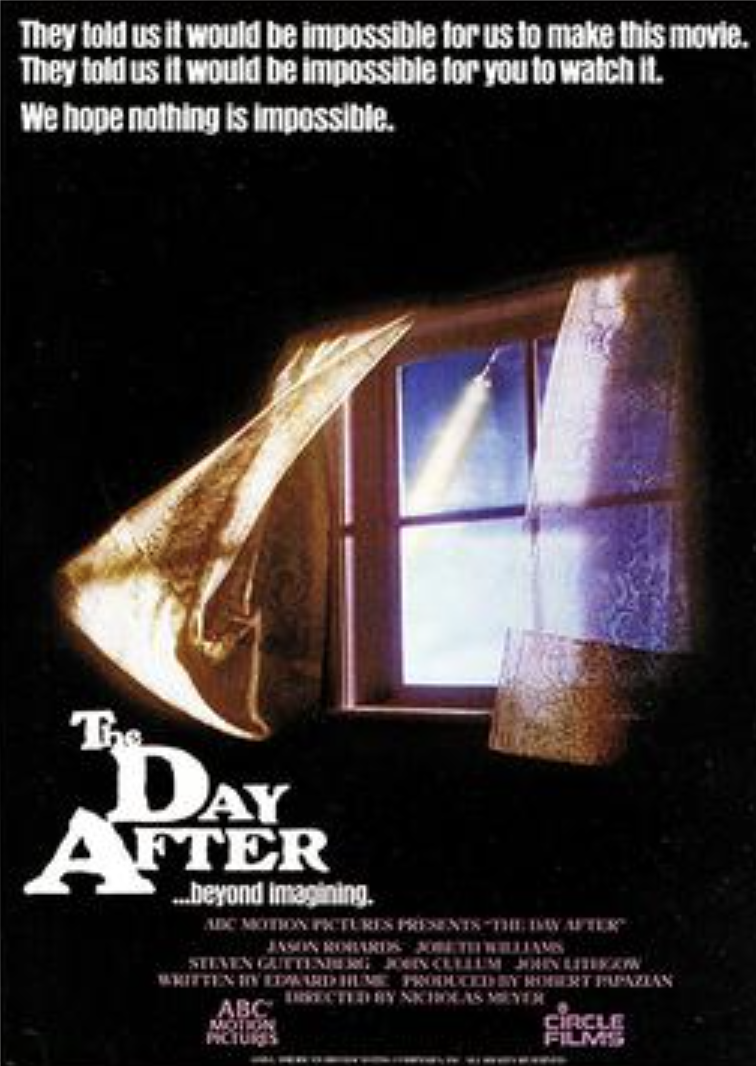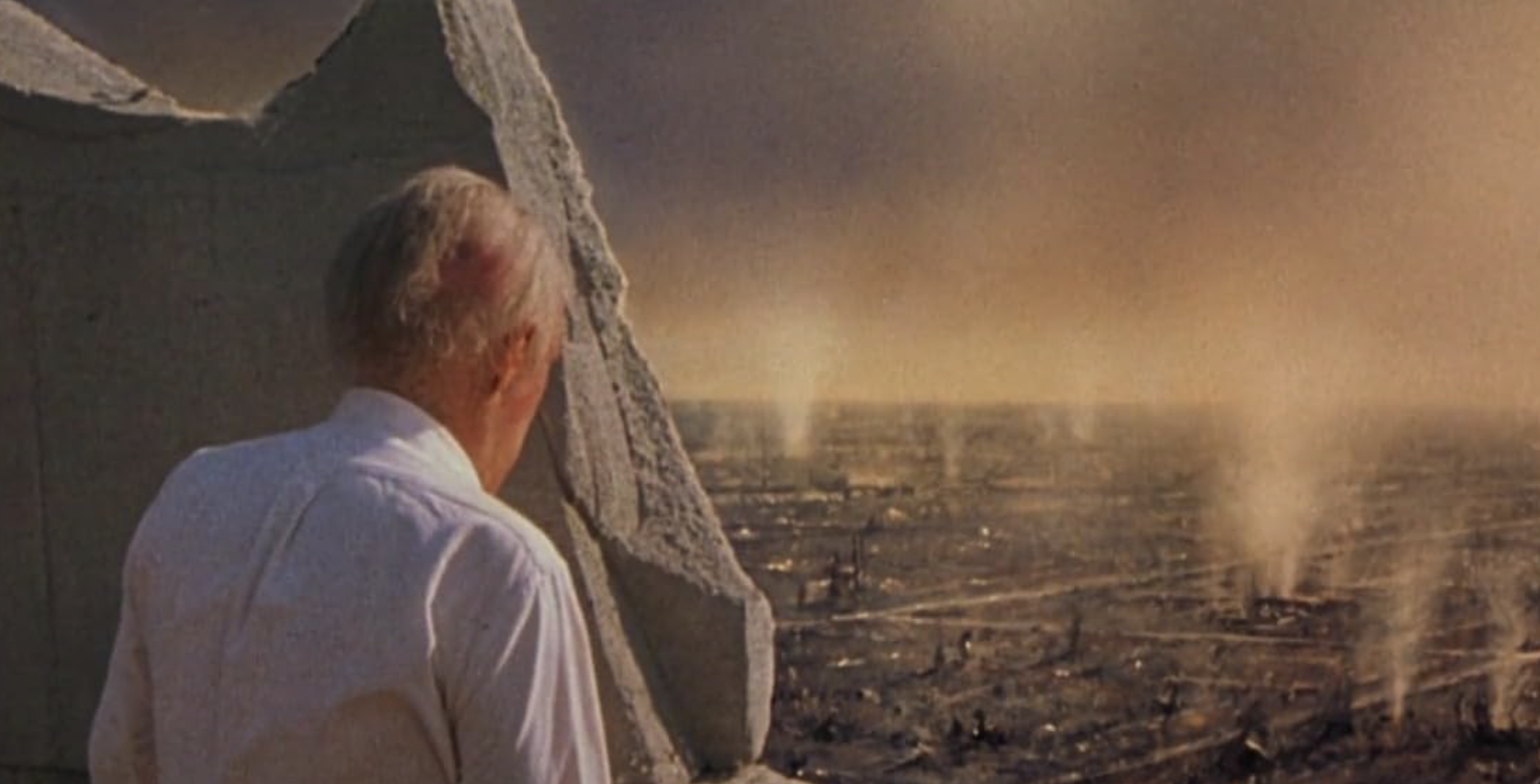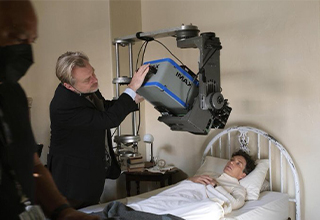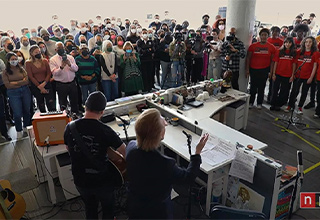10 Pics Remembering The 1980s Nuclear War Network TV Movie No Kid Have Should Seen
Carly Tennes
Published
12/11/2024
in
creepy
Though a nuclear attack was the last thing anyone wanted to envision during the height of the Cold War, 'The Day After' decided to go where neither Soviet nor American had before. Portraying a realistic depiction of nuclear war, the film was as controversial as it was impactful, not only attracting roughly 100 million viewers, but also making its way to the screens of some of the world's top policy makers.
From the script's origins to Ronald Reagan's diary entry, here are 10 pics remembering 'The Day After.'
- List View
- Player View
- Grid View
Advertisement
-
1. The Day After
 Courtesy of IMDBWhile life may often imitate art, we’re deeply relieved such wasn’t the case for 1983’s terrifying — and controversial — nuclear war flick, ‘The Day After.’
Courtesy of IMDBWhile life may often imitate art, we’re deeply relieved such wasn’t the case for 1983’s terrifying — and controversial — nuclear war flick, ‘The Day After.’ -
2. Nuclear Tipoff
 Courtesy of ABC‘The Day After’ started as the brainchild of ABC executive Brandon Stoddard. Inspired by ‘The China Syndrome,’ Stoddard tapped fellow ABC higher-up Stu Samuels to write the script. He named his work’ The Day After,’ a tribute to the film’s themes of ongoing disaster following a nuclear strike.
Courtesy of ABC‘The Day After’ started as the brainchild of ABC executive Brandon Stoddard. Inspired by ‘The China Syndrome,’ Stoddard tapped fellow ABC higher-up Stu Samuels to write the script. He named his work’ The Day After,’ a tribute to the film’s themes of ongoing disaster following a nuclear strike. -
3. Constant Controversy
 Courtesy of ABCFrom its inception, ‘The Day After’ proved controversial, with several expressing concerns about realistically portraying nuclear war onscreen. With a team of expert SFX artists, producers asked Nicholas Meyer to direct — the third potential director they approached. Despite his worries about potential network censorship of the film’s gruesome subject matter, Meyer signed onto the project.
Courtesy of ABCFrom its inception, ‘The Day After’ proved controversial, with several expressing concerns about realistically portraying nuclear war onscreen. With a team of expert SFX artists, producers asked Nicholas Meyer to direct — the third potential director they approached. Despite his worries about potential network censorship of the film’s gruesome subject matter, Meyer signed onto the project. -
4. Early Woes
 Courtesy of ABCAs Meyer began delving into the gory details of what a nuclear war would look like stateside — a venture that allegedly made him sick every evening after clocking out — he often found himself at odds with not only ABC censors, but also with the Department of Defense. The government agency insisted the filmmakers have the Soviets strike first, a creative direction Meyer and the movie’s team wanted to avoid.
Courtesy of ABCAs Meyer began delving into the gory details of what a nuclear war would look like stateside — a venture that allegedly made him sick every evening after clocking out — he often found himself at odds with not only ABC censors, but also with the Department of Defense. The government agency insisted the filmmakers have the Soviets strike first, a creative direction Meyer and the movie’s team wanted to avoid. -
5. FEMA Fails
 Courtesy of ABCThe Department of Defense was only the beginning. During his research, Meyer reached out to FEMA to inquire about their nuclear preparedness plans. Upon learning the agency had only considered putting nuclear evacuation information in regional phone books, he allegedly called FEMA a “complete joke.”
Courtesy of ABCThe Department of Defense was only the beginning. During his research, Meyer reached out to FEMA to inquire about their nuclear preparedness plans. Upon learning the agency had only considered putting nuclear evacuation information in regional phone books, he allegedly called FEMA a “complete joke.” -
6. Censorship Concerns
 Courtesy of ABCThe film’s release was pushed back by six months as a result of censor-mandated edits. One edit, which Meyer said struck him “as ludicrous,” involved the removal of a scene in which a child woke up screaming from a nightmare about a nuclear holocaust. The edit, he said, was particularly egregious “when contrasted with the huge doses of violence to be found on any average evening of TV viewing."
Courtesy of ABCThe film’s release was pushed back by six months as a result of censor-mandated edits. One edit, which Meyer said struck him “as ludicrous,” involved the removal of a scene in which a child woke up screaming from a nightmare about a nuclear holocaust. The edit, he said, was particularly egregious “when contrasted with the huge doses of violence to be found on any average evening of TV viewing." -
7. The Day Before Project
 Prior to ‘The Day After’s’ release, Meyer leaked the movie to a pair of anti-nuclear activists, who then sent copies to other activists and peace organizations. Nicknamed ‘The Day Before’ project, the frenzy sparked screenings and discussions among media outlets and civilians alike. Several politicians and even the Pope allegedly wanted to watch the film. This political tie-in, per Variety, was considered “the greatest PR campaign in history.”
Prior to ‘The Day After’s’ release, Meyer leaked the movie to a pair of anti-nuclear activists, who then sent copies to other activists and peace organizations. Nicknamed ‘The Day Before’ project, the frenzy sparked screenings and discussions among media outlets and civilians alike. Several politicians and even the Pope allegedly wanted to watch the film. This political tie-in, per Variety, was considered “the greatest PR campaign in history.” -
8. The Big Premiere
 Courtesy of ABCAfter months of promotion and warnings to viewers about both the film’s sensitive subject matter and the dangers of nuclear war as a whole, ‘The Day After’ premiered on ABC on November 20, 1983.
Courtesy of ABCAfter months of promotion and warnings to viewers about both the film’s sensitive subject matter and the dangers of nuclear war as a whole, ‘The Day After’ premiered on ABC on November 20, 1983. -
9. Reception
 Courtesy of ABCMore than 100 million viewers tuned into the premiere, making ‘The Day After’ one of the most successful TV movies in history. Alongside an initial warning about the movie’s disturbing scenes — and a hotline viewers could call to speak to counselors — the film was followed with a discussion including several famous faces, including Carl Sagan, Henry Kissinger and Elie Wiese.
Courtesy of ABCMore than 100 million viewers tuned into the premiere, making ‘The Day After’ one of the most successful TV movies in history. Alongside an initial warning about the movie’s disturbing scenes — and a hotline viewers could call to speak to counselors — the film was followed with a discussion including several famous faces, including Carl Sagan, Henry Kissinger and Elie Wiese. -
10. Broader Impact
 Courtesy of ABCBeyond landing 12 Emmy Award nominations — two of which the film won — ‘The Day After’ struck a chord with American policymakers, including then-President Ronald Reagan, who wrote that the movie was ‘very effective and left me greatly depressed.’ Word of the film’s impact among American officials ultimately made its way back to Meyer. “If you wanted to draw blood, you did it. Those guys sat there like they were turned to stone,” a friend of Meyer’s who worked for the government said of a screening they had attended.
Courtesy of ABCBeyond landing 12 Emmy Award nominations — two of which the film won — ‘The Day After’ struck a chord with American policymakers, including then-President Ronald Reagan, who wrote that the movie was ‘very effective and left me greatly depressed.’ Word of the film’s impact among American officials ultimately made its way back to Meyer. “If you wanted to draw blood, you did it. Those guys sat there like they were turned to stone,” a friend of Meyer’s who worked for the government said of a screening they had attended.
The Day After
While life may often imitate art, we’re deeply relieved such wasn’t the case for 1983’s terrifying — and controversial — nuclear war flick, ‘The Day After.’
While life may often imitate art, we’re deeply relieved such wasn’t the case for 1983’s terrifying — and controversial — nuclear war flick, ‘The Day After.’
10/10
1/10






![More than a Myth: 28 Viral Internet Rumors That Turned Out True <p>There is no shortage of <a href="https://trending.ebaumsworld.com/pictures/21-local-rumors-that-turned-out-to-be-true-later-on/87483931/">crazy rumors</a> on the internet, but every now and then one of them has an element of truth to it. Here are 28 famous internet rumors that turned out to be spot on. </p><p><br></p><p>In the 1980s, Tim Burton made a version of Hansel and Gretel that appeared on television one single time during the Halloween season. The one-off showing would have been completely forgotten, however, had it not been for one Redditor. "I heard it was fake but I knew it was real because my dad recorded everything in the 80s," u/Frozenthickness wrote. After getting a friend to convert it from VHS to DVD, the movie made its way onto the internet. "I know it's our copy because the tracking in the beginning is [messed] up." Thanks to Frozenthickness, one more work from a legendary director lives on. </p><p><br></p><p>Speaking of legendary artists, many people speculated for years that the music to the 1994 "Sonic 3" video game was made by the one and only Michael Jackson. However, everything was kept under wraps to avoid breaching Jackson's studio contract. Lo and behold it was all true. The tracks themselves however were ironically sung by an impersonator. </p>](https://cdn.ebaumsworld.com/thumbs/2023/12/14/125906/87486617/web-rumors-fixed.jpg)






0 Comments